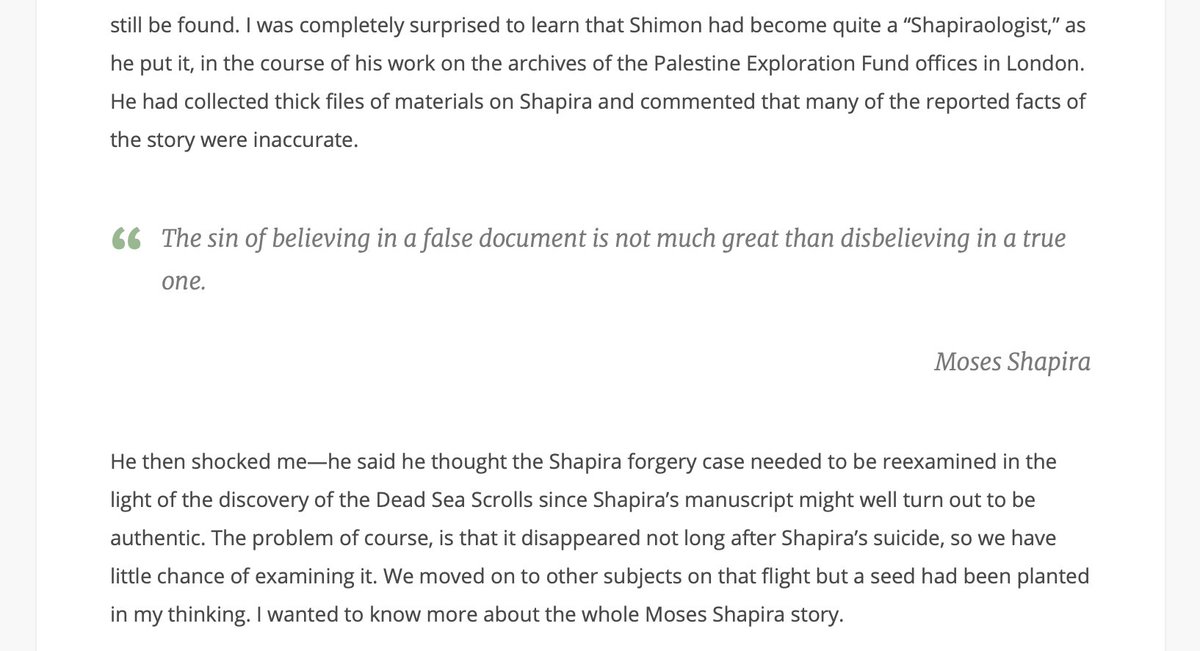
Jerusalem Post has an interview with Eitan Klein (deputy director of IAA's theft prevention unit) about the recent announcement of Judean Desert finds.
Several things here worth attention . . .
jpost.com/jerusalem-repo…
Several things here worth attention . . .
jpost.com/jerusalem-repo…
Klein repeats the claim that the trigger for the survey project came with the appearance of the "Jerusalem Papryrus" on the antiquities market -- without noting that it's likely a forgery. 

Is anyone familiar with the "Bar Kochba-era parchments" that the article claims were discovered by looters in a cave in 2009? 

Similarly, this seems like an odd reference to "fragments of Hebrew script from the Second Temple Period" found in 2016 -- especially given the claim the new scroll fragments are the 1st found in 60 years. Is this real? Is it a misunderstanding by the journalist? 

This certainly *does* seem to be a misunderstanding by the journalist: previous reporting made clear that the IAA has *surveyed* around 500 caves, but only excavated in a few select ones. 

Further highlighting that budgetary issues might have been one reason for the IAA's announcing the finds when they did. 

Just like Uzi Dahari (former IAA deputy director): "Israeli archaeology is not conducted on behalf of any ideology, nor does it explicitly serve the heritage of the Jewish people on its land. It is pure science . . ." 

This is interesting, since in his interview w/the Norwegian weekly Morgenbladet Klein said the trash used to date looting ranged from 50-60 years ago to the last *20* years -- why not highlight 2 years ago there, especially since the journalist was questioning the "race" aspect? 

If you want to read a much more illuminating critical look at these issues, take a look at the Morgenbladet article (and I don't say this simply because they interviewed me -- the piece is quite well done).
morgenbladet.no/aktuelt/2021/0…
morgenbladet.no/aktuelt/2021/0…
UPDATE: Stephen Goranson has pointed me to the publication of the "Bar-Kochba era parchment" seized in 2009
jstor.org/stable/23075008
jstor.org/stable/23075008

Eshel, Eshel, and Yardeni note that it was reported seized on May 6, 2009 by the IAA's theft prevention unit.
They suggest it may have come from the "Cave of the Tetradrachm" in the West Bank, because that cave was known to have been dug by looters in 2008-9.
They suggest it may have come from the "Cave of the Tetradrachm" in the West Bank, because that cave was known to have been dug by looters in 2008-9.

Here's news coverage of the arrest:
nbcnews.com/id/wbna3060565…
nbcnews.com/id/wbna3060565…
However, based on the information from the journal article & the news report, it's not clear (as Klein claims or the journalist interpreted) that the item was actually dug up in that specific cave or that it was in 2009.
https://twitter.com/MichaelDPress/status/1380224499736535042
But the incident does help provide more background for the claims of looting in these caves in recent years, used to justify the current Judean Desert survey.
• • •
Missing some Tweet in this thread? You can try to
force a refresh












